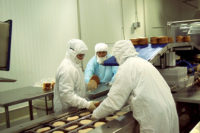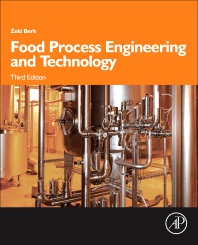Quality Control
Why Food Production Facilities Should Replace Common Cleaning Products with Non-Toxic, Non-Corrosive Alternatives

Photo by JESHOOTS.com on Unsplash
As consumers, we trust that our food is safe for consumption. We expect the food production facilities, where our food is made, to be clean and free from harmful contaminants. However, food production facilities face unique challenges in maintaining a clean and safe environment. One of the most significant challenges is using cleaning products that contain toxic chemicals. These chemicals can pose a serious risk to employees and consumers, and facility managers should consider replacing these harmful cleaning products with toxic-free, non-corrosive alternatives.
The Risks of Toxic Chemicals
Many common cleaning products contain harmful, toxic, or dangerous chemicals such as ammonia, bleach, and phosphates. These chemicals can cause various health problems, from skin irritation to respiratory issues. They can also harm the environment, contaminating waterways and harming wildlife. In food production facilities, toxic chemicals can pose an even greater risk. If these chemicals come into contact with food, they can cause serious health problems for consumers.
In a study by the National Institute of Health, researchers state the danger of food exposure to common cleaning chemicals in the packaging and production process, “Disinfectants and most cleaning agents contain harmful compounds that have a pungent smell and corrosive properties. Notwithstanding their role in the deep cleaning of surfaces and the environment at large, they can easily be introduced into food through mishandling and unsafe practices, leading to residual toxicity.”
Corrosive Chemicals and Equipment Damage
In addition to the health risks of toxic chemicals, many common cleaning products are also corrosive. This means that they can cause damage to equipment and surfaces over time. In food production facilities, this can be particularly problematic. Corrosive chemicals can damage machinery, leading to costly repairs and downtime. They can also damage surfaces such as countertops and floors, making them more difficult to clean and increasing the risk of contamination.
Fortunately, there are alternatives to traditional cleaning products that are both non-toxic and non-corrosive. These products are made from natural ingredients and are free from harmful chemicals. They are just as effective at cleaning as traditional products but without health and environmental risks. They are also gentle on equipment and surfaces, reducing the risk of damage and prolonging the life of machinery.
Introducing Viable Alternatives
As the dangers and limits of toxic cleaning chemicals are becoming more widely understood, more and more industries are adopting new strategies to replace them with environmentally friendly, non-toxic alternatives.
Viking Pure Solutions is one company at the forefront of this movement. It provides customers with the means to produce electrolyzed water (e-water) cleaning and disinfecting solutions made through a patented process. Though using electrolyzed water as a natural cleaning agent might sound unusual, electrolysis technology dates back to the 1960s. It has already been adopted in many parts of the world as a safer and more effective alternative to chemicals.
Electrolyzed Water is made from electrolysis when salt is electrically separated into its two main ions, sodium and chloride. Those two ions are mixed into separate fresh-water streams, producing two solutions—a highly powerful all-natural alkaline cleaning and degreasing solution, and a hypochlorous acid (HOCl) disinfectant.
These products are reportedly safer, stronger, and more sustainable than the harsh chemical products most commonly used today. Most importantly, they are more effective at killing bacteria and stopping the spread of disease, which means they can play an important role in creating a safer, healthier world.
Improved Safety for Employees & Reduced Environmental Impact
Replacing toxic cleaning products with non-toxic alternatives can improve safety for employees. Toxic chemicals can pose a serious risk to employees’ health, particularly those who work with these products regularly. Using non-toxic cleaning products, food production facilities can reduce the risk of health problems such as skin irritation and respiratory issues among their workforces.
The use of non-toxic cleaning products can have a positive impact on the environment. Traditional cleaning products can harm waterways and wildlife, contaminating ecosystems and contributing to pollution. E-water cleaning and disinfecting solutions are made from natural ingredients and are biodegradable, meaning they break down naturally over time. This reduces the environmental impact of cleaning and helps to protect the planet.
Cost Savings
Replacing toxic cleaning products with non-toxic, non-corrosive alternatives can also lead to cost savings for food production facilities. Electrolyzed water solutions can be less expensive than traditional products, enabling facilities to save money on cleaning supplies. In addition, non-toxic products such as e-water are less likely to cause damage to equipment and surfaces, which can reduce the need for repairs and replacements.
Companies can also go one step further by producing on-site non-toxic cleaning solutions. This eliminates shipping costs and logistical complexities that have challenged various industries for years.
Viking Pure serves as an example of this trend. By allowing clients to produce solutions on-site, cleaning crews have unlimited access to as much e-water as their facilities demand, with the same level of maintenance it takes to gas up your car. On-site generators empower companies to have enhanced control over the cleanliness of their facilities. What’s more, the solutions produced by the Viking Pure generator are Green Seal certified, organic, and don’t contain allergens or additives, states the company.
As infectious diseases present new levels of threat, it becomes more critical for companies and organizations to ensure consistently clean environments for their workers, clients, and beneficiaries. It can also be exponentially more cost-effective as a long-term solution.
Improved Product Quality
Finally, the use of non-toxic cleaning products can lead to improved product quality. When toxic chemicals are used in food production facilities, there is a risk that these chemicals will come into contact with food, leading to contamination and risk of brand-damaging recalls. Non-toxic cleaning products reduce this risk, helping to ensure that the food produced is of the highest quality.
Concerning food production, product quality matters more than any other industry. Consumers are tasting your product daily—the slightest change in flavor, or the feeling that something is “off” with the texture or taste of a food product can have large implications on how consumers perceive your product and your brand. Protecting your reputation is key. In addition to the actual taste, consumers’ perception of your product and the standards of quality and cleanliness during production play a major role in their likelihood to purchase and recommend your products to others.
The spread of foodborne illness is another serious concern affecting millions annually. According to the Centers for Disease Control and Prevention (CDC), “1 in 6 Americans get sick from foodborne diseases yearly”. These illnesses can range from mild stomach upset to severe and life-threatening infections. The most common foodborne illnesses are caused by bacteria such as listeria, E. coli, and salmonella. Surfaces in food production facilities can be breeding grounds for these bacteria, which can develop adaptive resistance to common disinfectants, including hydrogen peroxide, sodium hypochlorite (bleach), and quaternary ammonium compounds.
One of the most effective ways to prevent food borne illness is to use a disinfectant that can kill these harmful bacteria. One such disinfectant is hypochlorous acid (HOCl). HOCl is an all-natural, hypoallergenic, and environmentally friendly disinfectant that is highly effective against many bacteria, viruses, and fungi.
HOCl destroys the cell walls of bacteria, causing them to break down and die. A key advantage of HOCl over common disinfectants such as hydrogen peroxide and sodium hypochlorite (bleach) is its efficacy in killing microbes with adaptive resistance. Studies have shown that HOCl kills pathogens more quickly and effectively. Unlike other disinfectants, HOCl is safe for use on food-contact surfaces without rinsing afterward, provided it’s produced around 180 parts per million, like Viking Pure’s HOCl Disinfectant. Using a disinfectant like HOCl can help prevent the spread of harmful bacteria and keep ourselves and our families safe from food-borne illnesses.
Moving Forward
As we learn more about the dangers of toxic chemicals to the human body, it’s only natural that food production facilities should replace common cleaning products with non-toxic, non-corrosive alternatives. These products offer a range of benefits, from improved safety for employees and improved product quality.
Non-toxic alternatives also have the added benefit of protecting both the environment and a business’s bottom line: e-water solutions, for example, are less likely to cause damage to equipment and surfaces, reducing the need for costly repairs and replacements. This can lead to significant cost savings for businesses over time.
By switching to electrolyzed water cleaning and disinfecting solutions, food production facilities can create a safer, healthier, and more environmentally friendly workplace for employees and consumers.
Looking for a reprint of this article?
From high-res PDFs to custom plaques, order your copy today!





-Photo-by-Clay-Banks-on-Unsplash.jpg?height=200&t=1692630940&width=200)




